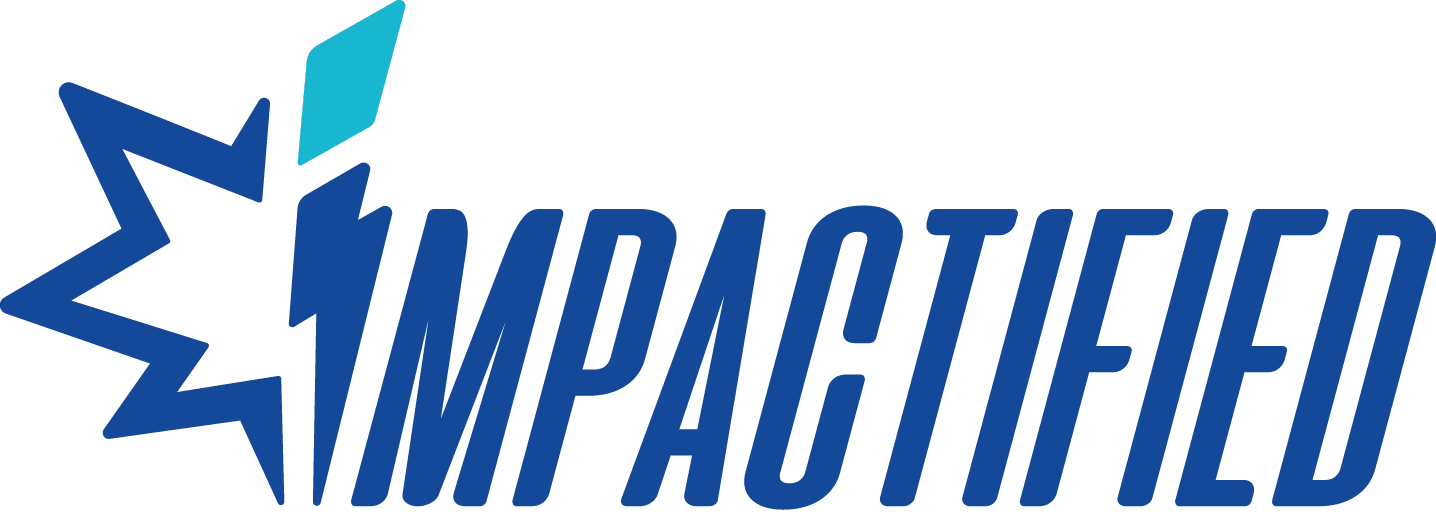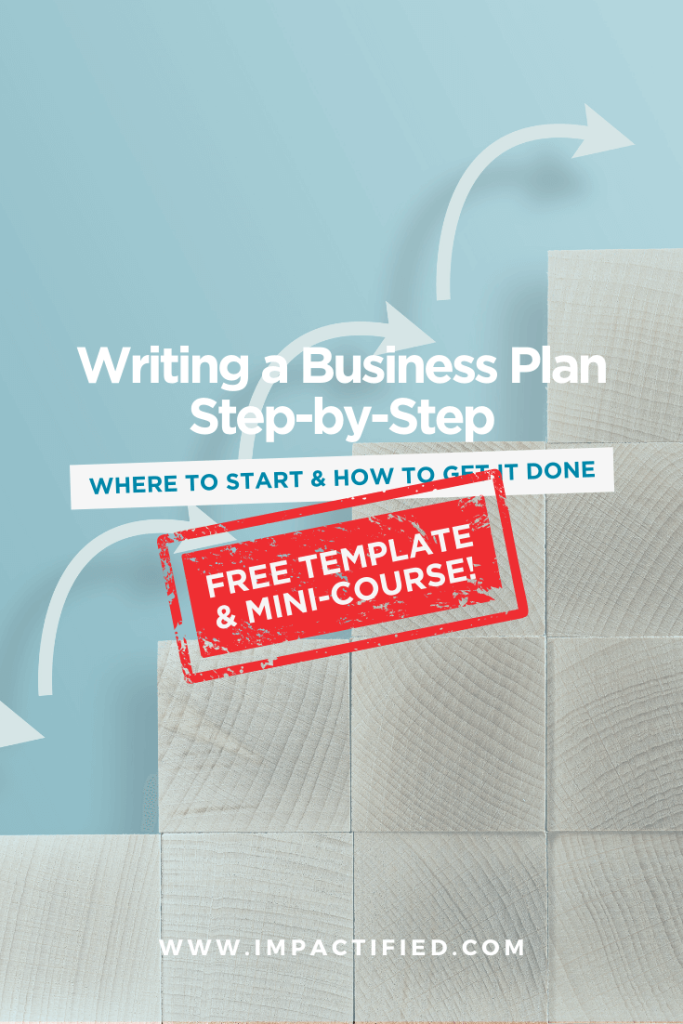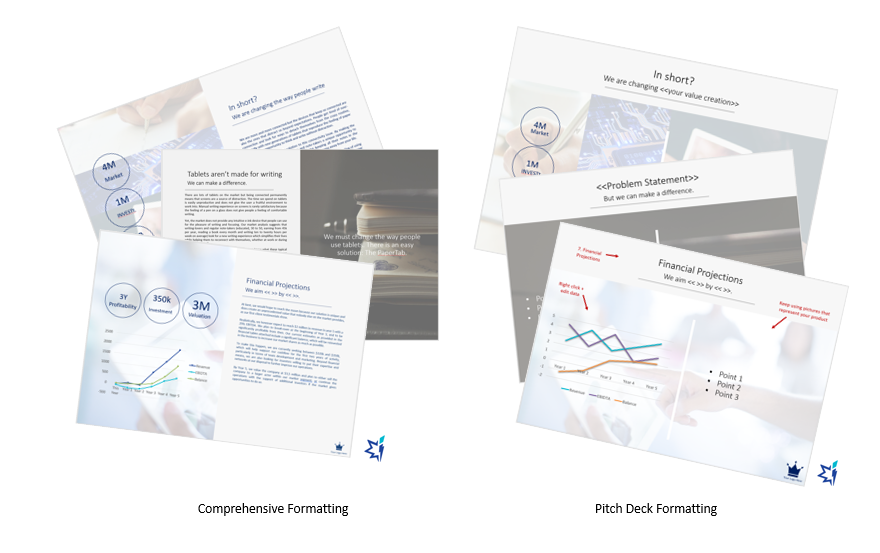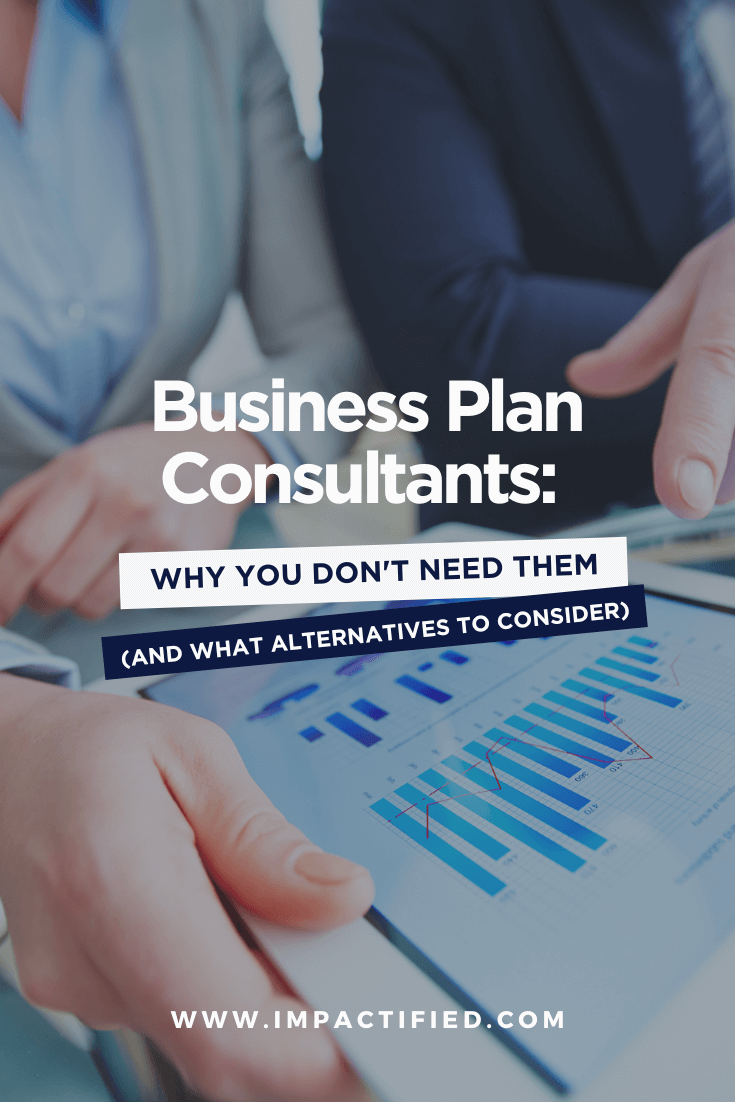Initially published June 29th, 2020. Updated April 12th, 2022.
If you are reading those lines, chances are that you are one way or another exploring the question of business plan writing for whatever project you have in mind. But… the topic is complex and takes a significant mix of expertise and time (a lot of time) so you’re not sure where to start.
Now, there’s good news and bad news…
The good news is that, if you look around, there are a lot of articles out there on the web explaining how to write something that makes sense. Sounds quite helpful, right? Hmmm.
The bad news is that only a portion of those articles will actually help you sort things out and produce something you can rely on. Those articles give you the generalities, that’s for sure, but will you be able to get to something tangible on your own? Probably not.
So where can you start?
At Impactified, we support entrepreneurs in their business journey and we’ve been asked numerous times for business plan writing tips – among other things. And guess what? Every time, the questions are pretty much the same.
Are free business plan templates good? What should we put into our business plan? What questions should we answer?
How long should the business plan be? How technical should it be? Is this really about business planning or is it BS?
How do you build the financial plan, by the way? What is the best format? Oh, and is it worth putting over $5000 into such a document? Hmm, but you wouldn’t have a simple and free business plan template, would you?
These questions are extremely common, so we’ve built this page to help you get results in no time, starting right now, with a step by step business plan writing guide that’ll take you through the process, AND a free business plan template you’ll be able to download to see what the result should look like.
Before we get into the details though, let us give you a tiny bit of background! We are professional business coaches (and entrepreneurs ourselves), and our job is to push business owners to their next steps. Business planning and business plans are part of that, so this page is part of a free series of articles on how to write a business plan.
We provide about 80 percent of our content for free, but in case that’s not sufficient, we’ve also created our Business Plan Builder Module, which gives you access to a complete and solid business plan writing work-frame tool, two designer-made templates (comprehensive + pitch deck), and about two hours of videos recorded with a business coach to explain all the logic you’ll need to master.
About this article…
Now, let’s get back to our topic of the day: step by step business plan writing!
In this ‘how to’ article, we’ll focus on a few important things.
First, we’ll start from the basics and explain why having a business plan typically helps small business owners and why it is a good idea. Sometimes, that’s actually not a good idea at all, so we’ll also look at the traps you should avoid. We can’t really skip that, can we?
Second, we’ll break five business plan writing myths and ditch some nonsense generalities we keep seeing again and again – you have noooo idea.
Third, we’ll get into the details and guide you through the business plan writing exercise – for real. No BS, we promise!
And fourth, we’ll finish with some final recommendations.
Now – spoiler alert: the article is a bit long, but what we’re doing here is take you by the hand to help you build your own business plan so that makes sense. If you’d rather save this article in a .pdf format to work on it at your own pace, you can also download it at the end of the page! We’ll also send you our free business plan template pdf and sign you up for our business plan mini-course for FREE – Limited-time offer !
Why is having a business plan a good idea?
All right. So, let’s start with the basics: why is having a business plan a good idea for your business – or not?
The funny thing is that explaining what a business plan is about is pretty much like describing an elephant in a corridor. It’s obviously something big, and you really (really) can’t miss it, but figuring out what on earth the thing is here for is kinda difficult.
Some give it a lot of attention and struggle to get it out of the way. Others dismiss it like it’s not even here. And you – yes, you – are left with the difficult task of figuring things out on your own.
In a nutshell? A business plan is much more like a Swiss knife than an elephant. You should have it with you in case you need it, but it doesn’t need to control your life.

There are two typical questions to consider here, really.
One: what’s a business plan and what is it for? Long story short, the idea here is to produce a storytelling superpower you’ll be able to use whenever you need to pitch your business. We explored the topic in this other article so please follow the link to find out more.
Two: why is a business plan important for your business? Beyond the pure storytelling aspects we just mentioned, that is. Again, please follow the link if you are not too comfortable with the concept!
Overall, investing some time (and money) in composing a business plan gives you an opportunity to set a clear big picture of what you plan to achieve and a list of criteria to figure out whether things work as planned. Of course, down the road, that business plan also gives you some easy-to-discuss materials you can share with people – especially those you’d like to get on board for whatever reason, whether that’s partnership development or fundraising.
Do you want someone’s opinion on what you have in mind? Share the plan.
Do you need a loan? Is your banker asking for projections? Share the plan, it’s all in there, no big deal.
Did you find a potential investor who’s asking to see what you have in mind? Again, done.
Are you wondering whether this new investment makes sense? The plan is there to give you a reference and decide.
Kinda makes sense, doesn’t it?
5 business plan writing myths to break
Now, before we begin with the step by step guide, we’d also like to break a few myths and ditch some BS generalities we encounter very regularly. Simply put: no, business plan writing is not just a pointless game for consenting adults. And no, business plans aren’t just a financiers’ stuff either.
As we just suggested, they can become a real business planning tool for entrepreneurs and business owners more generally. They can play a really strategic role in an entrepreneurial project. And they probably are one of the most powerful tools when it comes to creating some storytelling that converts.
Having a Business Plan is BS
The first preconceived idea we keep hearing and hearing again is that investing time and money into a business plan is BS, and that the work is mainly a fake game between consenting adults perfectly aware of the exercise’s futility.
On a tech community website, Professor Philippe Silberzahn for instance wrote a rather spicy op-ed criticizing the idea that business takes preparation. His message was that entrepreneurship is a matter of trying and doing, so that prep’ing entrepreneurs for what comes next isn’t what matters.
We don’t agree with that.

Silberzhan was right with one important thing: an entrepreneur should focus on building and doing instead of focusing too early on excessive planning. Lean management is the only sensible thing out there, therefore – YES – starting a business with a business plan phase is an absolute waste of time because that type of plan comes from nowhere and creates no value whatsoever.
BUT! Rejecting the planning and prep’ing part ‘just’ because the business is at an early stage makes no sense.
From our real-life business coaching perspective anyway, what clearly matters is to prove that your business is already matching demand and has a market (that’s the so-called product-market fit, by the way). To that extent, having an up-and-running business is indeed a lot more important than working on a business plan. YET! Ditching the prep’ part of building a business is pretty much like driving a car randomly, without any particular route. You burn fuel and money but do you get anywhere at all? Nope. It makes no sense.
What matters, said differently, is to find a happy medium between doing and planning because, like it or not, both work in pairs. Potential customers and marketing plans are great, but actual customers and actual income statements are worth more.
Some will tell you that you don’t need a business plan, others will tell you that you absolutely need one, and both will be wrong. As an entrepreneur, you will sooner or later need to put your plans on paper, all it takes is some good old Entrepreneurship 101 common sense and a justified trigger. More on that in a minute.
Business plans are a one-size-fits-all exercise
The second typical myth we keep hearing again and again is that business plan writing is ‘just’ a matter of getting funding, so all you need is a one-size-fits-all document you can then recycle as much as necessary. But that’s also wrong.
For starters, there are different types of financiers, and all have different expectations so a one-size doesn’t fit all.
Bankers are one of the interlocutors possibly interested in learning about your business directions and projections – and they want to see stability and security. Investors are another type of beast.
A banker is risk-averse and will mostly be interested in making sure that your business projections will enable you to repay whatever you borrow within the next few years. If you are looking to secure small business loans, therefore, the point is therefore to convey a sense of stability and security.
Investors are much more interested in making a significant return on investment five years from now, when your then successful business will be worth something. In their case, the point is therefore to suggest profitability and cash-out.
Business partners of all sorts could also be interested without being finance professionals, so you also need to be able to speak to them in their own language. Some entrepreneurial mentors outside of your personal circles might be willing to help and will expect a minimum of planning from your side of things.
So? The type of business plan you are about to write should differ depending on who you plan on talking to. Don’t just look for a free business plan template: think about the various ways you have to use it!
Now that being said and more importantly, you – as an entrepreneur – are probably the most relevant user of the business plan you are thinking about writing. Before you can tell anyone what you have in mind when it comes to building your business, you need to know for yourself. And as it turns out, building a business plan is precisely about helping you clarify your plan! If you don’t do that work, who will?
Structuring? meh… We’ll see how it goes!
The previous point leads us to how important business plan writing is in terms of… structuring!
In essence, going through the whole exercise should give you some storytelling superpowers, but to get your story clear you’ll first need to structure your thoughts (and business).
Once that’s settled, the story itself must also be structured efficiently to ensure that the business plan isn’t too long, that it is easy to read, and that it is easy to remember.
To do that, the key idea is that your document should be formal enough (i.e. formal but not too formal) so as to show that your business is robust from seven distinct angles, which need to be compiled into a very specific business plan outline and structure. This structure looks as follows.
One, your plan must show a clear big picture of your business. What is the big idea? Do you even have one? How clear is it? How tangible is it? Is it reasonable? Crazy? Are you in business already?

Two, it must demonstrate that your business solves a problem and thus is a solution people want to pay for. For instance, if you are working on business plan for a sewing and tailoring shop, then you need to show that you already have clients (market) and a way to stay relevant to those clients despite having competition in town. Ultimately, if there’s no problem to solve for people, there is no need for a solution and no need for spending money either. Right?
Three, your business plan writing exercise should be an occasion to show that you have thought about demonstrating traction and about your go-to-market strategy. Or, said differently, it must show that you know what you do and that you have considered the thing pragmatically.
Four, your operations must make sense because sourcing or research and development are serious topics and people will want to know that you know. Uh uh…
Five, your management team must be brought forward as being the team for that project. Why? Because the people behind a business are more important than the business itself. You wouldn’t put money on the business of someone you don’t trust, would you?
Six, you must show that you have thought about the numbers. This includes detailing your costs, your break-even estimates (that’s the cash flow part), but also your profitability, your funding needs, and your valuation plans. You’ll also need the financial tables which come from the previous point (and these are usually a nightmare, especially if you don’t have a lawyer or an accountant who can make things up for you).
Seven, you also need the so-called executive summary, which whilst it comes first on paper should be written last because it summarizes the whole thing.

Overall, your work should follow that structure precisely, there’s no real margin here. But that’s a very efficient way to build a story people will remember. Again, download our free business plan template and see for yourself!
Business plan writing is mostly blabla…
Let us repeat ourselves here – the point is important The difficulty for entrepreneurs does not stop at the level of the content itself. It also relates to the difficulty of putting things into shape. Into the right shape, and with the right amount of words. If you’ve looked around for business plan templates and guides, you’ve probably seen a lot of word documents made of plain text on a white page. And that’s … dull.
Why? Make an educated guess…
So?
Come on…
All right… whoever is reading your document is probably human (yeah it’s an impressive thought, right?) and they probably read a lot of plans just like yours.
So, if your document is the typical traditional business plan, made of boring words on way too many white pages, you’re done. Unless your business plan is actually dynamic and exciting to read, chances are that you’ll bore your readers to death before they even read the third page – which for you is usually the end of the adventure.
The point, therefore, is to find the right mix to make your business plan look sexy and memorable.
The information needs to be sharp, and it has to convince the readers that you make sense. But that’ not all. The tone also needs to be sharp, thought-provoking and appealing to give your readers some incentives to ask for more. Not to mention the fact that they might even pass your document to other people if the format talks to them.
Some – particularly investors – will actually want to read as little text as possible. The big ideas, keywords, numbers and illustrations would typically be enough with them, because what they want is a quick & sharp snapshot of what you have to sell, whilst the actual content will actually come out of your mouth as part of your pitch.
The two cases are different, it goes without saying. In the former, the idea is to explain concisely, with a bit of storytelling. In the latter, the idea is to evoke and give support to whatever discussion is about to take place.
The longer version of the business plan would be particularly suitable for your banker, or for a funding application, while the shorter version (the pitch deck) would be the one you’d discuss in person. Of course, in many cases going through the longer version of the business plan is a very good way to draw a clear big picture which can then be summarized with clear and sharp words in a pitch deck.
Makes sense, right?
We mentioned our Business Plan Builder at the beginning of the article, remember? Well, if you’ve already downloaded the free .pdf template we gave you access to at the beginning of this article, you probably see what we mean very clearly. The model is built with space, illustrations, colors, and the amount of text on each page doesn’t exceed 300 words on average! And we’re not even mentioning the pitch deck template!
Take a look at these screenshots borrowed from our free business plan template (and Business Plan Builder). At the end of the day, your business plan should be clear and easy to read. The document itself should create curiosity, and the reader must know that you know your stuff.
Look, it’s simple! Your content can’t be too long to read (otherwise your readers want to die, right?) so on a more comprehensive format, you’ll want to make sure that every key topic is dealt with on one single page.
The formatting must be dynamic, and well-illustrated with pictures that match your product or services. The pitch deck, in turn, needs to be much lighter and has to go straight to the essential numbers and keywords the reader must remember.
One template is obviously shorter than the other, but as long as you keep things concise and logical then you should be okay.
Finance guys are all the same.
Step by step business plan writing should have the merit of making your business plan look appealing, but beyond design, your content should also be seriously sharp. And what that means is simple: you need to adapt your business plan to your reader.
If you are preparing a business plan for an investor:
For instance, if you are talking to an investor, the key point is to suggest that your business will be valuable enough three to five years from now to make the investor some serious profit. As a general rule, investors expect that one on ten businesses they invest in will be profitable down the road – Yes, one on ten isn’t much, so you must make sure that your business plan will convey the right idea to them: i.e. you aren’t making a bet, you are seriously into the business and you are going to make them some serious money!
You will also need to be able to provide a cap table like this one (capitalization table, to be exact) showing your potential partner what you are about to give them, in terms of shares and value.

If you need help understanding that logic, note that we are explaining everything in the video modules accessible with The Business Plan Builder. Of course, the automated financial tables will also produce that type of table for you – have a look!
If you are preparing a business plan for a banker:
If your interlocutor is a banker, the story is going to be a bit different because their expectations are very different. An investor wants to get their money times five or ten five years from now, remember? Well, a banker doesn’t.
They want their money back as soon as possible, month after month, and they’ll only give you some cash if, when looking at your business plans and at your cash flow statements, they have the certainty that you’ll be able to repay.
As we said before, investors fund long-term projects when bankers tend to fund short-term cash flow needs. Some might even say that bankers only lend money to those who already have it, right? So, instead of showing your banker your valuation five years from now and your capitalization table, give them what they want. Be sure that you can match the various ratios they’d expect from you, and give them some financial history to play with. As you can see, there’s a page explaining that in our Business Plan Builder:
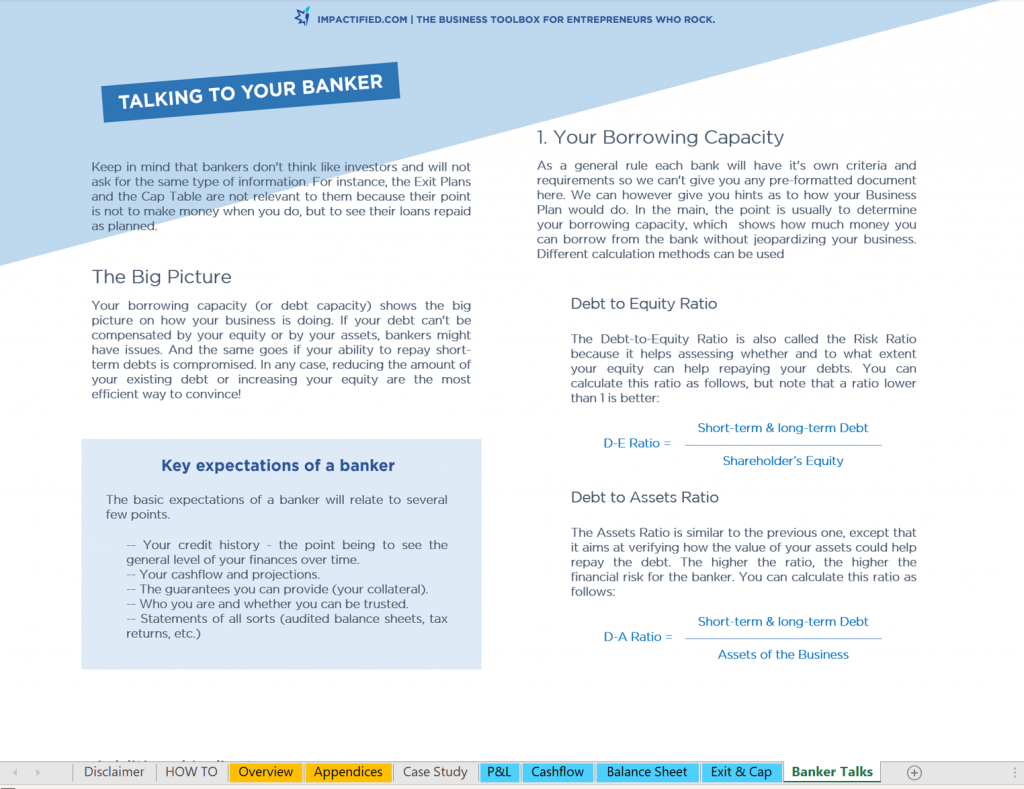
In both cases though, the key is not to just produce a pdf document, and it is not to just pitch an idea either. It is to plan a business that has real chances to deliver. It is to show that you can plan for business opportunities and surprises. It is to demonstrate that you are in the process of planning a business development strategy that makes sense for you and for them.
Step by step business plan writing guide
Now, let’s get to the step-by-step business plan template part itself. How you can do it, where can you start, what questions need to be answered… we’re going to take you by the hand and will guide you through the main parts of the work.
Shameless plug here, but the best way we’ve found to show you how to write a business plan step-by step is to use our Business Plan Builder work frame for illustration purposes. Feel free to ignore that part, of course, or secure your access now and start saving some time immediately! After purchase, you’ll receive a link to a downloadable .zip package in which you’ll find five documents, all designed to take you through a step by step business plan writing exercise
As you can see in the picture below, all can be used with the basic Office Suite – no need for an online connection, no unnecessary fuss!
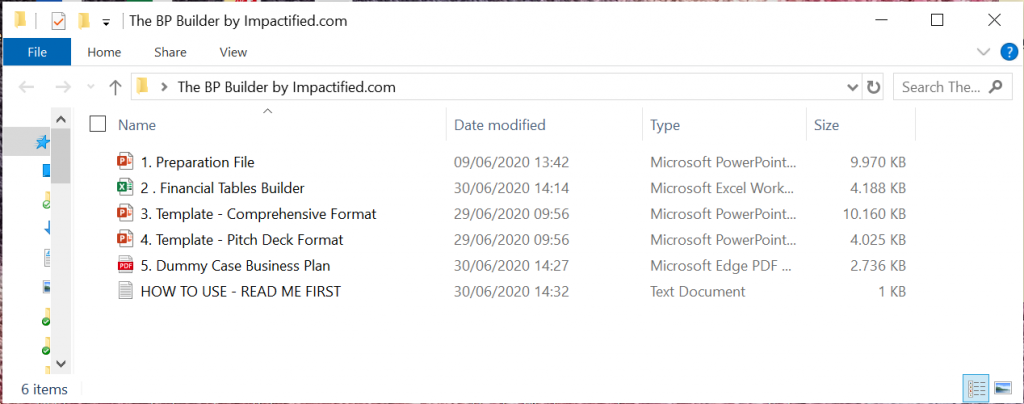
The “read me” document explains how the various documents work with each other.
The “preparation file” is the core working document in which you’ll be invited to answer five important questions for each of the various topics we’ve listed before. We’ll guide you through the whole process with questions and suggestions, and we’ll give you boxes with calibrated space to answer with the right amount of words.
Because we know that coming up with the financial tables is a nightmare for many people, we’ve also added an automated spreadsheet that will help you come up with numbers that make sense. Again, all you’ll have to do is follow our guidelines (more on that below) and the financial tables will build under your eyes.
Last but not least, once you are done with answering the questions and building the tables, the “formal template” document will give you a printable format in which you’ll simply copy and paste your answers before clicking print. Et voila! Easy as 1, 2, 3. Of course, the remaining document is the template for the Pitch Deck format. You get the idea.
Getting into the core of the business plan
Now, this efficient yet simple business plan template will make you focus your attention on seven distinct aspects of your business which come as follow.
-
An Executive Summary
-
A big picture presentation
-
An offering presentation (with your market analysis and competitive analysis)
-
A go-to-market strategy presentation, with a brief marketing plan
-
An operations presentation
-
A team presentation
-
Your financial projections and the corresponding financial documents
In reality, these parts are listed this way for presentation purposes. In practice, they would be managed and written in a different order to make sure that everything makes sense. For instance, the Executive Summary would be written at the end, while the financial tables would need to be ready before the financial projections and the go-to-market strategy can be written in full.
Overall, the art of coming up with a business plan consists in focusing on two important questions.
One relates to what your readers will want to read in your document. Long things short, they want to know that you know your thing, that you have done your math, and that you can create value for them.
The other relates to what YOU need to do in order to build a project (or scale it up if it’s already up and running). As mentioned before, a business plan is like a roadmap for an entrepreneur. Things don’t need to be constraining, but they nonetheless provide a trajectory worth defining earlier than later. That trajectory ought to be easily explained in the big picture section of the business plan, by the way.
All that being said, here’s the step by step business plan mapping exercise we promised.
Step 1: Writing your big picture
The ‘big picture’ section of your business plan is likely to be the first one you’ll work on because it explains, well, the big picture of the project. Smart, isn’t it?
In essence, you should answer the following questions.
-
Beyond having a great business idea, what problem have you identified on the market?
-
Who is affected by that problem, and what are they after?
-
What inspiring vision do you draw from this (and what amazing potential you see?)
-
How does your business create value for your target?
-
What makes your business proposition absolutely unique on the market?
These questions are not that easy to answer, are they? You need to find the right arguments, but you also need to make sure that everything flows in an easy way.
So, the best option is to break it down into several precise questions which, once put together, will provide the reader with a logical and easy-to-read answer.
How The Business Plan Builder works.
The Business Plan Builder does that work for you, of course, with simple and efficient boxes like these ones – which can then be used to produce a clean and final document.

On the left side, the empty box is designed to give you just enough space to answer one question. We give you a maximum of 65 to 75 words to fill that white box, but if you can do 50 words then by all means, please just do.
On the right side of the screen, another box gives you some insights as to why you need to think about that point, and how to come up with something smart.
That obviously sends a very bad message, so it is absolutely essential to figure out “why” you do “what” you do. Spending time on that point is probably one of the best investments you can make, think about it very hard!
For instance, in the case of Impactified the “what” is a toolbox full of business tools for entrepreneurs who rock, but the why relates to the idea that most entrepreneurs can’t afford an MBA and need a bit of help to develop their activity (i.e. supporters, advisers, a business coach acting as a number 2 they can talk to freely, etc.).
The why pushes us to do a better what, for starters, but it also helps to get people on board when we pitch what we do around us. So, what problem do you solve?

Once your problem (the “why”) is identified, consider “who” is affected by it. Showing that you know your customer or user (there can be a big difference between both terms) is important, but again many entrepreneurs fail to consider the question.
For instance, if your business sells solutions to a legal department that can’t decide anything because the investment budget is managed by another department, then the end-user is not the actual buyer and chances are that you’ll wait for a while before closing any deal.
Similarly, if you sell an architecture solution aimed at reducing design work in real estate development, your client might be a developer (who needs to save costs) but it might also be the architect himself (who wants to save time).
So, figure out who you are talking to and make yourself relevant. Again, make sure that you don’t write a novel here. Stick with the small box provided and trim your text until you obtain something that matches it.
After you’ve clarified what the problem is and who the beneficiaries (or customers) are, we invite you to clarify what we usually call “the need vs want gap”.
To keep things easy, think about the last time you went shopping and ended up buying something you didn’t need and you’ll be halfway through.
For instance, some of the people who buy expensive trendy smartphones do it because they love the brand (that’s a want) but not because they need that brand. What they need is a phone and they could go for a substitution product, but what they want is to sync their music or feel cool (to others, or as a personal thing) so what conditions their purchase is their want rather than their need.
Another example is that of charity-funded toilets in poor countries. Some NGOs go visit villages and install toilets that nobody uses. It makes no sense because they need those facilities, right? Yes, they do, but what they want is respect and dignity, so the fact that the toilets are free can be an obstacle because it denies this dignity. The people might need toilets, but they want dignity above all and will only use the equipment if they can pay.
We gave you a real estate example a minute ago, remember? We said that the developer needed to reduce costs, but the architect wants to save time to enjoy some holidays and quality time with family. Who do you think is the most likely to make the purchase here?
Business plans must also show vision and anticipation.
The fourth element you must absolutely include in your big picture description is the vision you have for the business.
Vision and mission statements s are often criticized as BS discussions that don’t pay the bill, but that’s wrong. Look at the storytelling in our free business plan template if you want an illustration here – what would the story look (and feel) like without a damn strong vision?
When it comes to writing a business plan (or reading one, depending on where you stand) the big idea is to show (or make sure) that the business has a long-term purpose, impact, and potential, and that it can make a big difference for a community which has a problem and which will want to buy the solution offered. That makes sense, right?
The point naturally leads to formulating a mission, i.e. a role towards your client community that actually guides what we do day after day (in contrast with the vision which is a long-term thing). Since we’re the example here, our mission, in turn, is to support entrepreneurs and help them move on with their projects, wherever they are.

Still reading?
Great. Let’s summarize things. We started from the problem your business solved, we identified your client and defined their want vs need gap. We formulated a why beyond a what, which gave us a long-term purpose (the vision) and a daily mission.
Said differently? Well. Whoever reads your business plan now has an idea of what you do and, more importantly, of why you do it. The “why” suggests potential and will create a connection between you and whoever will believe in your vision. It’s the beginning of everything, isn’t it?
There can be no complete business plan draft without a clear value proposition.
Last but not least, the big picture part of your business plan must tell the reader what your value proposition is, and why it is absolutely unique.
For instance, pitching yourself as a consultant is pretty much the same as marketing yourself with your “what”. It describes what you do but it doesn’t explain how you make a difference for your clients. Your what is a description, but it is not a value proposition!
For instance, pitching yourself as a consultant is pretty much the same as marketing yourself with your “what”. It describes what you do but it doesn’t explain how you make a difference for your clients. Your ‘what’ is a description, but it is not a value proposition! In contrast, pitching that you empower startups by building tech-related strategies is a clear value proposition that seems rare and highly desirable.
Again, look at the storytelling in our free business plan template: how inspiring is it? Can you see the point?
So, think about how your business creates value and formulate a clear, crisp, and sexy value proposition people will want to hear about, to remember and to repeat to others.
Make yourself different by focusing on the value you deliver rather than on the service you sell – this will give you an edge on the competition, and the reader will get your point loud and clear.

Again, our business plan template will guide you through the thinking and writing parts with some insights you can see in the picture above. Use your problem statement, your solution, and your vision to make up something compelling, and stick with it!
Be precise and sharp, and avoid the general BS.
To finish on that first key pillar of any simple business plan template, let us insist on one very important thing: be precise, be sharp and avoid the general BS.
We hear all the time that a project is super promising and that the founders will make a fortune by targeting one percent of the Chinese market, by becoming the best French restaurant in Japan, so forth and so on.
The reality is this one: you can’t legitimately survive with a pitch like these unless you have a very, very, very strong case to justify absolutely everything you claim. One percent of the Chinese market as an objective is a very common goal, and it’ll look great on your business plan if you want to be seen as an amateur.
Similarly, claiming that you plan on creating the best French restaurant in Japan suggests that the Japanese don’t have quality French restaurants (bad start), and chances are that someone will ask how you plan on competing with Quintessence, the three Michelin Stars restaurant where a menu is prepared for each table by a world-class chef. Good luck with that…
In short? Know your business, be sharp, avoid the BS.
Steps 2: Pitch your offering
The next two steps relate to your offering and to your go-to-market strategy, and once again the point is to show that you have thought about your topic carefully.
Talking about your offering is not just a matter of describing your product. Yes, the reader wants to know that the product is nice and that it will be sold eventually, however just because a dog might like his future hat doesn’t mean that the dog’s owner will buy it.
We talked about the difference between user and buyer before, remember?
The point is to explain to the reader that you have defined a clear market for your product. There is a problem so the product (or service) is a solution that people will want to buy for this reason and for that reason. We’re not going into the same depth of explanation as before with this point – our Business Plan Builder is there for that – but here’s the main points to keep in mind.
Demonstrate demand.
The reader wants another demonstration that you have a product-market fit, and they expect you to demonstrate that you already have a demand for whatever you do that justifies the investment you are about to make.
Market segment.
Beyond having a demand, you will also be expected to demonstrate that you have a precise target market segment in which there is some significant business to do. We talked about differentiation earlier, well this is typically the place where you show that the differentiation creates uniqueness and a competitive advantage for you.
Keep in mind that demonstrating the existence of competitors in your industry – especially if you have done a competitive analysis of the ecosystem – suggests that there is a healthy market to invest in. If there are no competitors, there might be no demand, right?
So here is food for thought.
What is your ecosystem looking like? Are your competitors mostly small businesses or are they a lot bigger? What market share do they own, and what market share could you expect to take over the next years?
Think creatively, build your market analysis carefully, and find ways to demonstrate that your product or service is in competition with others, but that you have an edge worth investigating.
From niche to market mapping.
This exercise about differentiation and segment definition has a major interest: it will help your reader realize that you have a niche (investors look for niches) in which you are unique and different. By the same token, knowing your niche means that you should be able to map your competitors based on key criteria specific to you.
We suggest that you use a graph like the one below to represent your market segment – and again, our free business plan template will provide you with everything you need to do it easily.

To give you an example, though, the typical dummy case used in our free business plan template takes the case of an e-ink new generation tablet which bases its competition analysis on the price and the writing experience provided to the client.
It really is up to you to build your own criteria depending on your own strengths and uniqueness, but the template will help you do that.
Step 3: A marketing / go-to-market strategy presentation
The third stake in the business plan writing exercise is twofold. One, you need to demonstrate that you have a go-to-market strategy that can create traction and interest. Two, you need to demonstrate that you already generate a certain degree of traction and interest. Simple, don’t you think?
Again, we invite you to explore six important element, the main of which are your business model, your marketing strategy and your ability to track.
Business plans require business models.
It sounds silly, but many people write business plans without talking about their business model, so make sure that you do. Explain how you plan on making money, starting with your pricing policy (do you have a no-brainer pricing at all?) and with your payment model.
For instance, do you plan on charging your clients on a one-shot basis, or do you offer a tiered-membership system that guarantees a recurring revenue for your business? Remember that investors don’t invest randomly – they buy a share of the income you plan to make five years from now so having a recurring business model is a major plus…
Marketing strategies too.
Your business model must make your business strong, but you also need a proper marketing strategy. That’s your marketing plan. The idea that clients will come to you if you build something cool is very seducing, but in reality things just don’t work like that, so you need to think ahead and plan. Including (and particularly) from a budget perspective.

What is your customer acquisition strategy, exactly? Think action (what needs to be done), for what budget (don’t be vague), and think outcome (for what results / sales). Write down numbers that can be used to illustrate your point, and make a compelling case!
KPIs and milestones.
We said that you ought to be sharp and precise earlier, remember? Well, the above requires one last thing: tracking, or evaluation depending on your preference.
One way to track progress is to set milestones over time (our business plan template gives you tools to illustrate your milestones over three to five years). In addition, you should think more generally about setting KPIs (Key performance indicators) which help you see whether results are being achieved at all.
Both terms are very similar and can be confusing, so think in terms of milestones in terms of actions (develop this, sign that) while KPIs would rather be numbers (reach 5 million in turnover, sign 50 A-type clients and 180 B-type clients, etc).
Ultimately, those indicators will really (really) help everyone out there.
As the entrepreneur, they will give you a direction, measurable goals to target, and a very good way to put a strategy into place to get there. As far as bankers, investors or partners are concerned, the indicators will create a more precise big picture while setting a context from which they’ll be able to discuss the project, your strategy and, probably, their involvement.

As before, see how that graph is presented in our free business plan template pdf document. Can you see the impact in terms of storytelling? Do the same!
Step 4: Your business plan must clarify your operations strategy
The next step – which as a reminder MUST fit in under a page – is to clarify your operations strategy. Typically, this part of the business plan template is very close to the very famous Business Canva (the typical lean business plan template, really) democratized in the New Business Model Generation book by Osterwalder and Pigneur.
Long things short, the point here is to explain “how” you are going to do “what” you plan on doing. Why, what, how… the sequence is logical!
So how to do that efficiently? Well, think about it for a minute. What would you like to know about your business if you read your business plan as an external reader?
Where are you in 3 to 5 years?
The first element here is to tell the reader what your operational structure will look like down the road. Three to five years from now, that is. Will your structure be local? Regional? International? How many people will you have in your team, for what kind of turnover?
The questions are numerous so you need to thing operational and pragmatic here. What do you have in mind exactly?
Again, the point is far from being the BS many people think it is. The idea here is to fantasize a little bit and dream big (yeah, you’re allowed) but more importantly it is to give you something to work from. We will talk about building your financial tables in a moment, but how to build tangible financial projections if you have no idea of where you want to be? Tricky, uh?
So, think serious and hard, draw a long-term big picture and describe it.
How will you organize sourcing, production, and distribution?
Our step by step business plan guide next moves to the topic of organization, but that organization is nothing if there is no production and, in most cases sourcing. The point is relevant if you sell goods, but services companies also need to produce insights and build teams capable of delivering, so the question is actually much broader than it seems at first.
For instance, will your organization develop horizontally and progressively acquire means and expertise to diversify and produce by acquiring competitors? Will it grow vertically by acquiring suppliers or distributors? Will it diversify by investing in various high-potential industries?
Will sourcing take place on a local or international scale? Will sourcing be secured or will it be vulnerable to market pressures against which you can’t do much? Or, said differently, will your sourcing represent a strength (to be invested into) or a weakness (to be talked)? You need to figure that out, really…
Of course, the discussion also applies to your distribution channels. Who will distribute your products and services? Do you have a network already or does it need to be built? Will you own that network, or will you need to build it? Any customer service in mind? How do you plan on doing that, really?

What partnerships do you need to build?
The last question in our step by step business plan logic brings us very naturally to the next one: our business plan template will make you think about partnership development.
Believe it or not, but that point is strategic in a business plan. Why? First, because the people you will pitch to know that you are not a superhero (you aren’t, right?) and that you won’t be able to do everything yourself. So, partnerships are a major enabler and they need to see that you plan on leveraging them.
Second, partnerships can be a key advantage and outcome of an investment deal. Would you give shares in your company to someone who doesn’t have a clue about what you do and only wants a share of profit? Not really.
Some investors can be onboarded for pure cash purposes, of course, but in many cases, founders will rather want to team up with investors capable of supporting their entrepreneurial journey. For instance, successful entrepreneurs can invest in a business while advising the founders on the strategy, others can bring expertise or a network.
It really is up to you, but as a general rule, what you want is to onboard people who are aligned with your “why” and can help get your “what” to the next level. Partnerships are a key part of your operations pitch, see how you can leverage them.
And, again… how will you monitor progress?
Again, think also in terms of progress. How do you define your operational targets? How can you quantify your goals, and how will you assess whether (or not) you have achieved them?
The point here is not necessarily to write everything down in full sentences, it is to be ready when it comes to throwing numbers at the people you talk to.
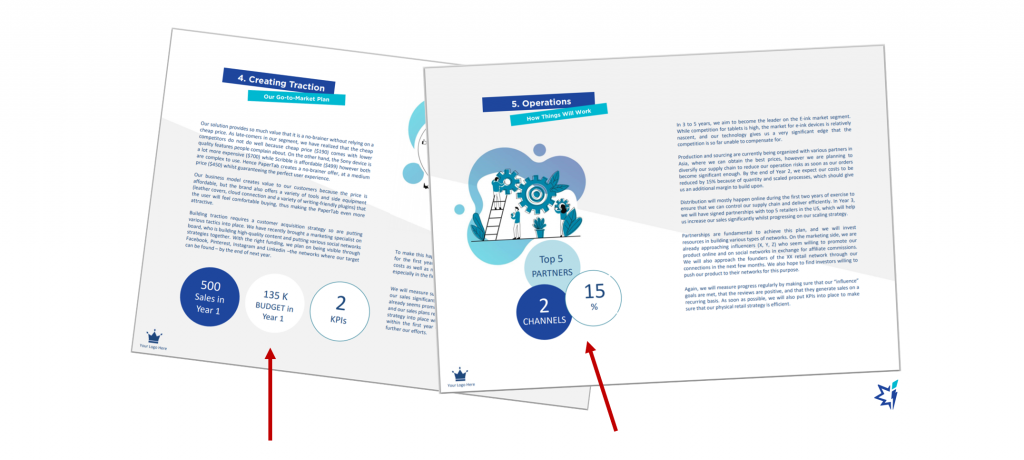
As you can see here, our free business plan template actually gives you space to input key numbers on every page you’ll produce. These need to be visual to attract attention. Ultimately, if the reader only skims through the page (which is usually what happens) they must be able to spot key numbers, and more importantly, remember them. So, set KPIs, set numbers, and use them as one big storytelling tool.
Step 5: A business plan must show that your business is about people. Oh yeah.
A key takeaway of Judy Robinet’s extremely good book on fundraising for startups is that investors invest in teams more than in products. To paraphrase the author’s words, investors would rather invest in a great management team with a correct project than in a correct management team with a great project.
Ultimately, bankers, investors, and partners invest in you because they trust you. So, your business plan must convey the idea that your people are fundamental, that nobody else can do the job, and that they can a-bso-lu-t’ly be trusted. Period!
Don’t put a CV in there, make clear who is who, who has which expertise, and who solves whatever problem you’ve encountered so far. To keep that part short: put yourself and your team forward and build some damn good (excuse our French) human capital. Oh yeah.
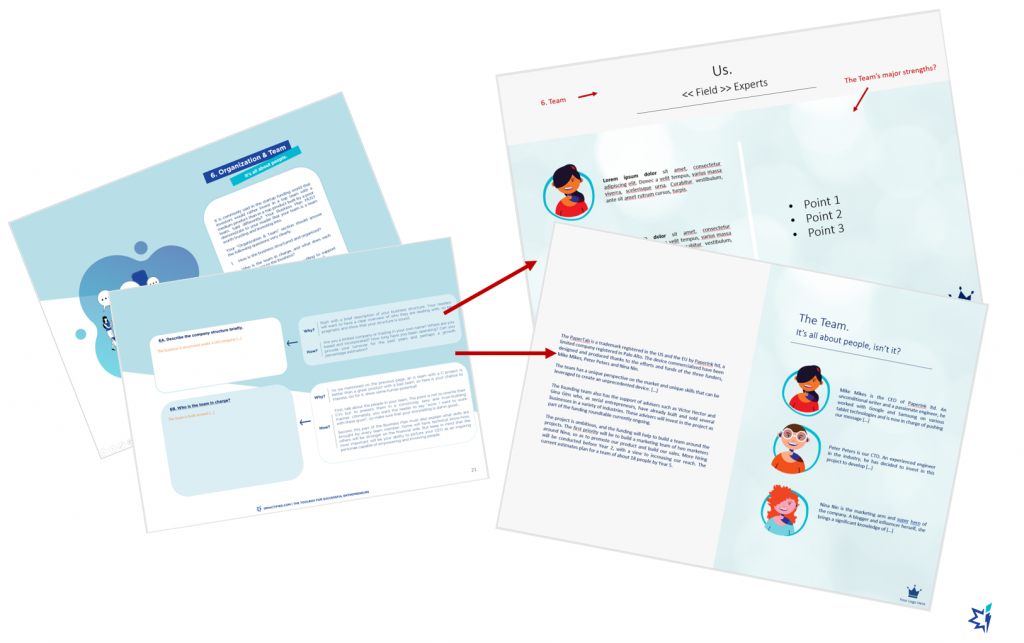
The team part of our Business Plan Builder invites you to think a little further, though. First, alongside people comes the actual structure of your business. Are you a limited company? An NGO? A sole entrepreneur? Note, if you answered ‘yes’ to the last, you might consider leveling up…
In addition to this, your business plan should also show that you are not on your own. Having a team is one thing, but being surrounded by entrepreneurs, mentors or advisers willing and committed to supporting you and your project makes sense.
Finally, the team section of the business plan is also the perfect occasion to discuss your team development needs. Who do you need to hire next? For what reasons? What budget do you need to get there? So forth and so on. Again, have a look at how we’ve drafted that in our free business plan template and think about how you could do the same!
Step 6: Setting your financial projections.
This won’t surprise you, but a step by step business plan work-frame also has to include financial projections and a reasonable financial plan on which your interlocutors will make assumptions. They will see what targets you have in mind, to start with, but they’ll also have a way to see how you think. Are you conservative, pessimistic, or optimistic? Do you know your market? Have you done your research?
Key considerations
Overall, the financial section of the business plan template should answer four big questions.
First, why so you need the money you look for, and when you plan on making your business profitable, for you and for whoever you are talking to?
Second, how you plan on burning cash and at what pace?
Third, what assets and liabilities would be held by the company and investors over time?
Fourth, what’s in it for them, now and down the road?
Interlocutors and languages.
A word of caution: know who you plan on talking to and be aware of your different interlocutors’ expectations.
What do we mean by that? Simple. A banker is a banker, not an investor, and the risk aversion level of those two will differ very significantly.
Bankers are likely to fund some operational needs (buying machinery, covering some cash burn needs for a given amount of time, so forth and so on) but they are less likely to finance a Business Plan per se – which is where investors become relevant.
Said differently?
Your banker will lend you money if they feel that you have the financial capacity to repay the loan within five years (and provided that you put some personal guarantees on the table). To the opposite, investors will not be interested in being repaid progressively but will hope to make a significant profit when selling their part of the business five years from now.
What financial projections ought to look like.
Now, what ought financial projections to look like? That question is usually the one-million-dollar question, both because it’s sinequanone to getting any sort of cash, and because building the tables properly is usually difficult.
Some have an accountant who can make things for them – but that takes time and money. Others pay consultants to build the math (and the rest of the document) but the cost is usually even more expensive. The rest usually manage by themselves, which tends to take a lot of time and a lot of energy – precisely the reason why we’ve built an automated spreadsheet inside our template!
Now, let’s get into the topic. Simply put, the financial tables of your business plan turn around 4 to 5 main elements.
The P&L.
The first element is the Profit & Loss table (P&L). Its purpose is rather simple: show your profits and losses – smart cookies, uh? At first, you provide your income estimates for the past three years and for the next five years.
After deducing your production costs and your overhead, you obtain your operational profit (or loss) also known as your Earning Before Interest, Tax, Depreciation & Amortization (EBITDA) and your net income or loss. Once the table is finished, it ought to look like this:
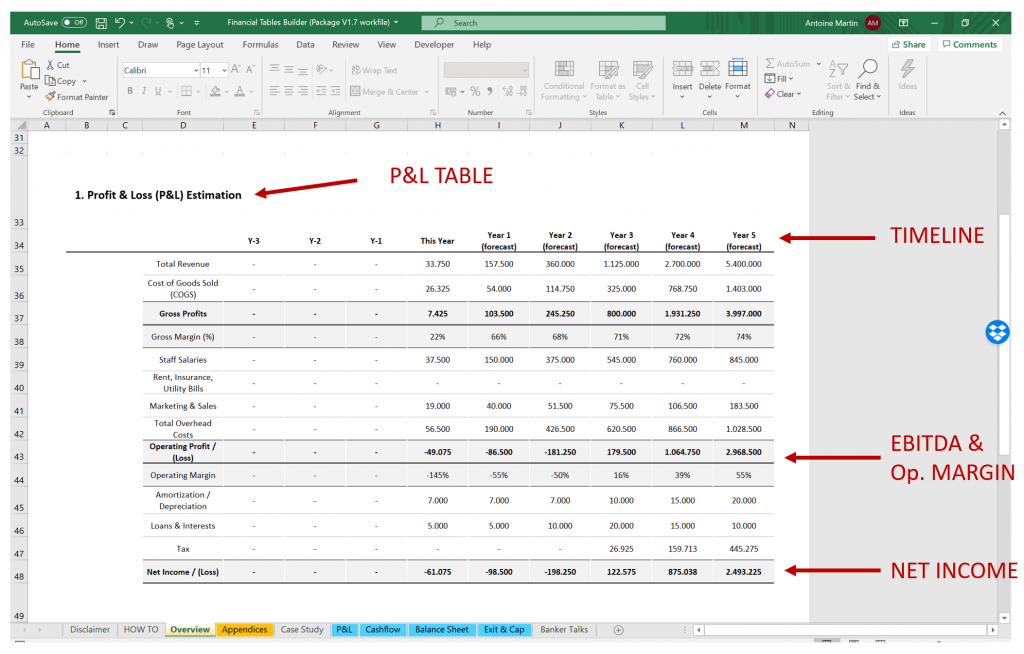
Since we know that getting to this table is rather a difficult task, we’ve built a semi-automated spreadsheet that will help you understand the full logic behind the whole table.
We are explaining what every line is about and how you can go from one to another, but we also give you tools to build the document itself – instead of throwing numbers out of nowhere.
Below is for instance the process needed to get to your gross profit / loss calculation (see the explanations on the left side).

Similarly, the table will get you through the process when it comes to defining your total overhead and your operating profit / loss, as well as your margin, so forth and so on.

Did you notice that some cells on the table are in blue, while others are in white or grey? This is where the automation comes in. For the past years, the numbers you need are already available in your financial papers so just pick them and enter them in the blue cells.
Building the forthcoming years is more difficult, however, so we’ve built an appendices section which are then compiled automatically in the white cells, whilst the math is then done automatically in the grey parts.
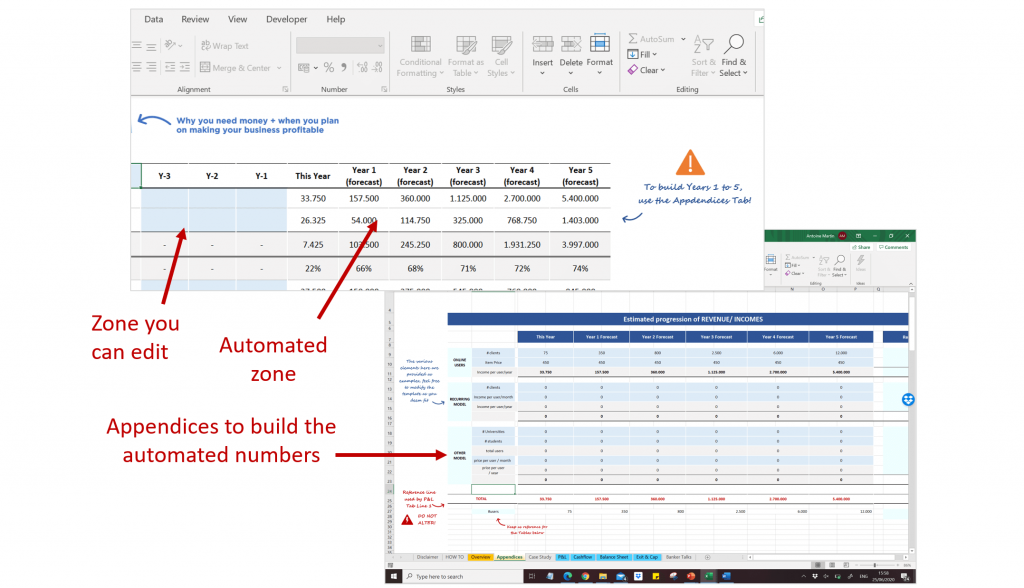
The appendices will help you model the income you expect. They’ll help you build your various types of expenses, so forth, and so on. In the end, all you have to do is follow the lead, think a bit, write a bit, and let the Business Plan Builder do the rest!
The Cashflow table and the Balance Sheet.
The second element is the cash flow table and its purpose is (smart cookie time again) to show how your cash flow is going to look for the years to come.
The table is built in a similar way, with automated cells that pick data from the P&L, explanations in red (so you can defend your estimates if someone asks), and grey cells that calculate key numbers.
As you can see in the picture below, the point of a cash flow table is to show how much cash is available and when, but also when funding will be needed to fill gaps (and when). Because your pitch will lead people to ask about budget needs, we also added a line in there that automatically fetches data in the document and compiles your overall budget needs year after year.

The Balance Sheet is the third key table that must absolutely be provided, and the good news is that we have completely automated it for you so there is absolutely nothing to do on that side of things. As you can see below, all the cells are either white (automated data) or grey (calculations) so you can just sit back and relax!
Having said that, the Business Plan Builder will nonetheless explain to you the logic behind the table (again, so you can explain by yourself): where the numbers come from, and what they actually mean, i.e. what the business owns and what it owes to third parties.
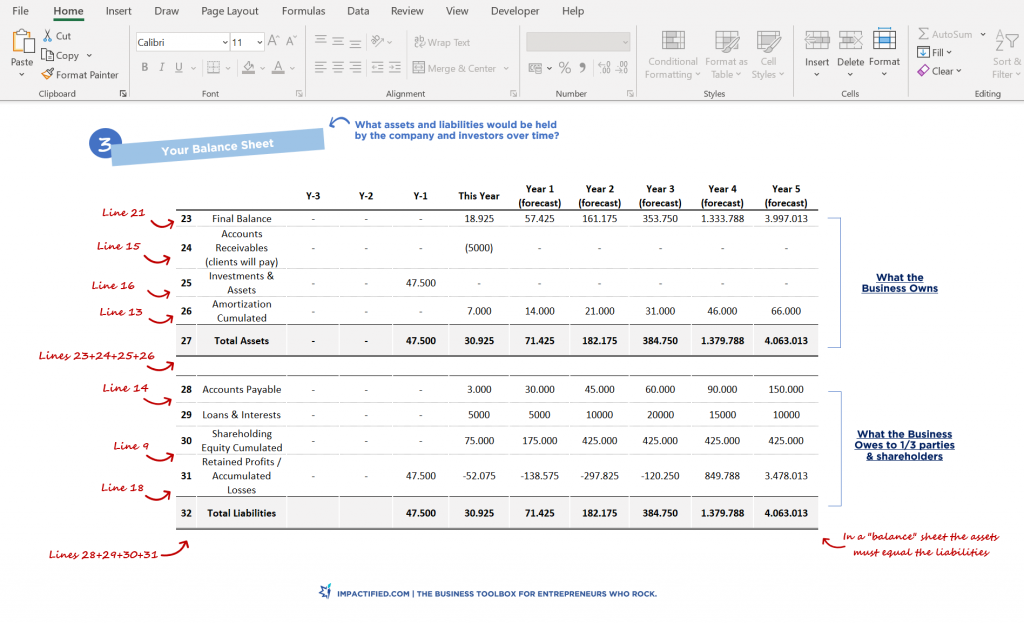
The Cap Table – a snapshot explaining what money people will make thanks to you…
The last step of the financial business plan is the capitalization table, and it is probably the most important part of it.
Long things short, the cap table is there for two reasons. The first one is to explain to the reader how much you value the business. The other is to show the reader how much money they’ll make if they put money in your business.
As you can see on the picture below, once again we have totally automated the table so all you have to do is to analyze it and think about whether your previous estimates make sense.
The only thing you’ll need to do (for real!) is to change the valuation factor in the blue box – typically a company is valued by multiplying the Year 5 EBITDA by 4 to 7, depending on the strength of the business and the recurring nature of its income.
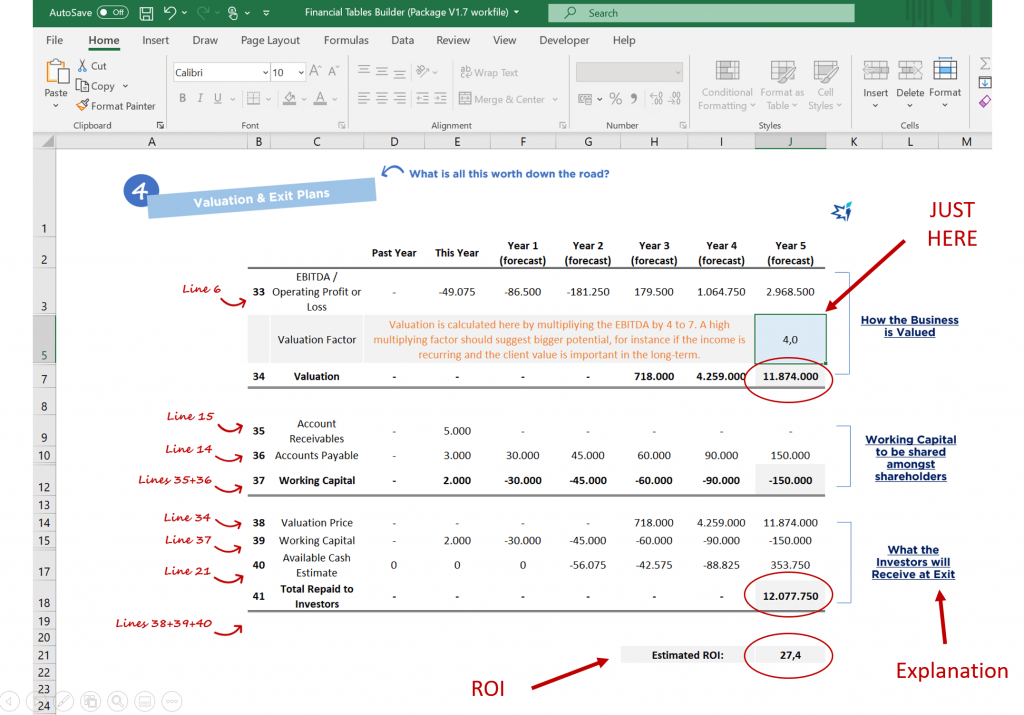
Ensuring that the valuation bit makes sense.
Once you’ve determined what your business could be worth five years from now (hint: it’s worth what investors are willing to say it’s worth, not more) the issue is to figure out whether the estimates make any sense at all.
To help you with this, we’ve added another layer to our capitalization table.
The big picture is rather simple: generally speaking, an investor is going to take between 10 and 15% of your company’s equity in exchange for the money you ask.
Said differently, the amount you ask ought to give you a major indicator of what your business should be worth to an investor. Hence you can easily calculate the difference between your valuation of the business and the valuation to be expected by investors.
The calculation isn’t very easy to do on your own, so we’ve once again automated it. The only thing you’ll have to do is change the blue cell (picture below) to have a calculation relative to the equity you are willing to give. How cool is that?
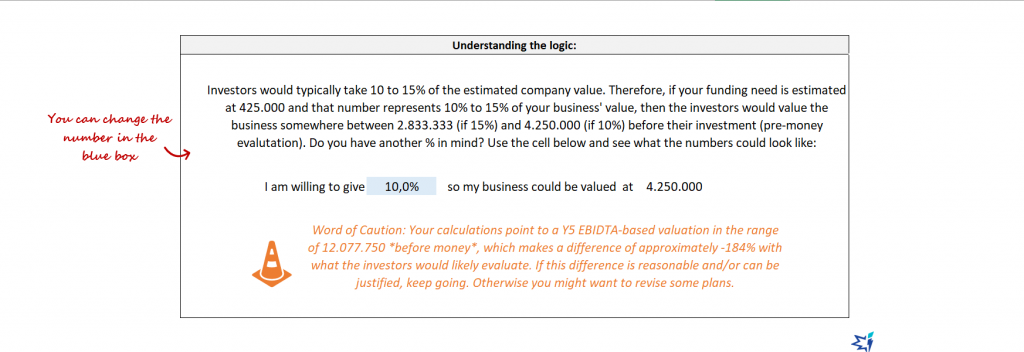
Equity & dilution.
Last thing as far as the capitalization table is concerned: a capitalization table also aims at giving the founders and the future investors an idea of how the business is going to be structured once the deal is signed.
Typically, the idea is to answer two questions: what will equity look like, and what will be the dilution for the existing shareholders. Yet the founders always struggle with the “how to manage this” part so we’ve also modeled the process.

The Business Plan Builder will take the various numbers available to build a representation of your company’s shareholding, both before the deal and after. This way, you will be able to estimate what impact your business projects could have on your company while having the right arguments to push the discussion as far as possible.
The white cell, blue cell, grey cell logic applies here as well – just input the shares you are planning to give away and let the Builder do the calculations for you.
Note that the table will automatically calculate the equity dilution for you (in orange on the picture). In case you wondered, dilution represents the relative loss of shareholding – in percentage – of the existing shareholders. For instance, in this case, giving 50 shares to two new investors lowers the percentage of the equity held by the existing founders by 9,1%.
Tip: as a general rule, giving away between 10 and 15% of your equity is acceptable, but more significant dilutions tend to raise flags.
Formulate your financial projections.
Now that your financial projections are set with numbers, you need to formulate them in an intelligible way. Back to our business plan template: we give you various ways to do that.
First, you want to build two scenarios for your business story. One has to be relatively optimistic, and the other must be much more conservative. At best, we would do… more realistically, we aim to…
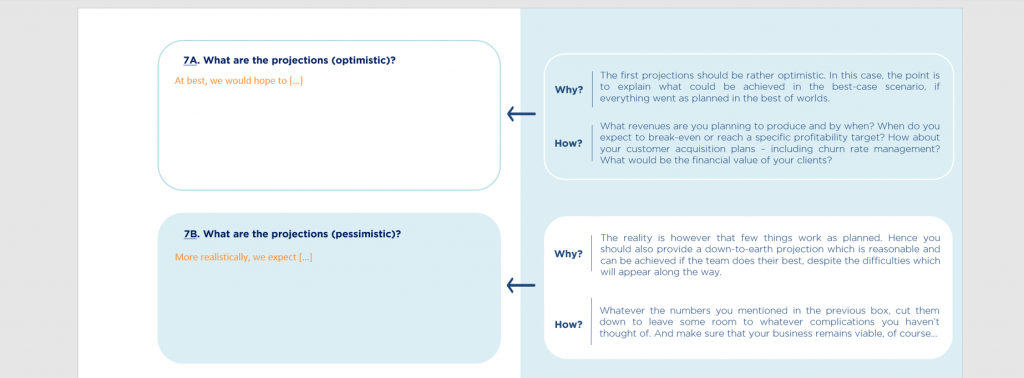 Again, the point is to show your interlocutors that you are not ‘just’ dreaming big. Quite the opposite, you know your story, you’ve thought about it and you’ve built various case studies – the most sensible of which you are now telling.
Again, the point is to show your interlocutors that you are not ‘just’ dreaming big. Quite the opposite, you know your story, you’ve thought about it and you’ve built various case studies – the most sensible of which you are now telling.The projections should also be illustrated with charts. Our business plan template provides a chart in which you can show your revenue, EBITDA, and balance estimations. Since you’ve produced those numbers in the previous steps, all it takes is a couple of minutes of reporting in the working document, and you’re good to go!

Last but not least, don’t forget to elaborate a little bit on what financial needs you have in mind… The point is to raise funding here, right?
By the way, in case you’re wondering what the financial projections in your business plan template would look like, here is another screenshot! Left side is the “how it works”, right side is the final result. Not bad, uh?
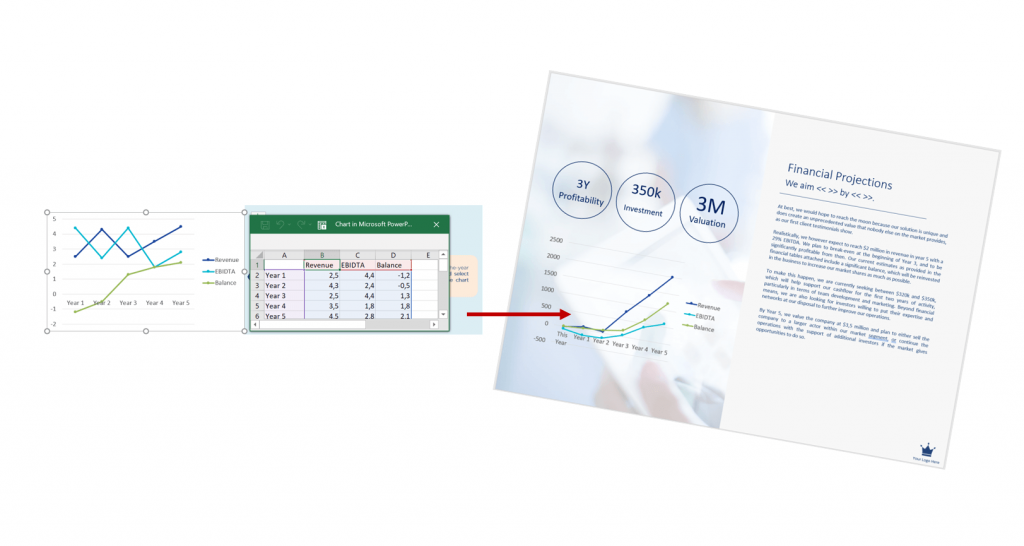
Step 7: The executive summary.
The last big section of our step by step business plan template is the executive summary which, as its name suggests, comes first in the final document. Still, you can’t write an executive summary without having all the cards in hand so it makes much more sense to write the summary last…
In the main, this section should demonstrate the following points very clearly: One, your business solves an actual problem for a real client. Two, you have a great team, which has a vision and is on a mission to change something. Three, your solution has a very unique value proposition which creates differentiation and competitive advantage. Four, the solution is already available / needs to be developed but requires […] to get to the next stage.
Overall, remember that your Executive Summary is your only occasion to make an excellent first impression, so polish it up and make it sharp, or it won’t attract the attention it deserves!
When using the template, the preparation tool (left) typically creates a formatted Executive Summary which looks like this:
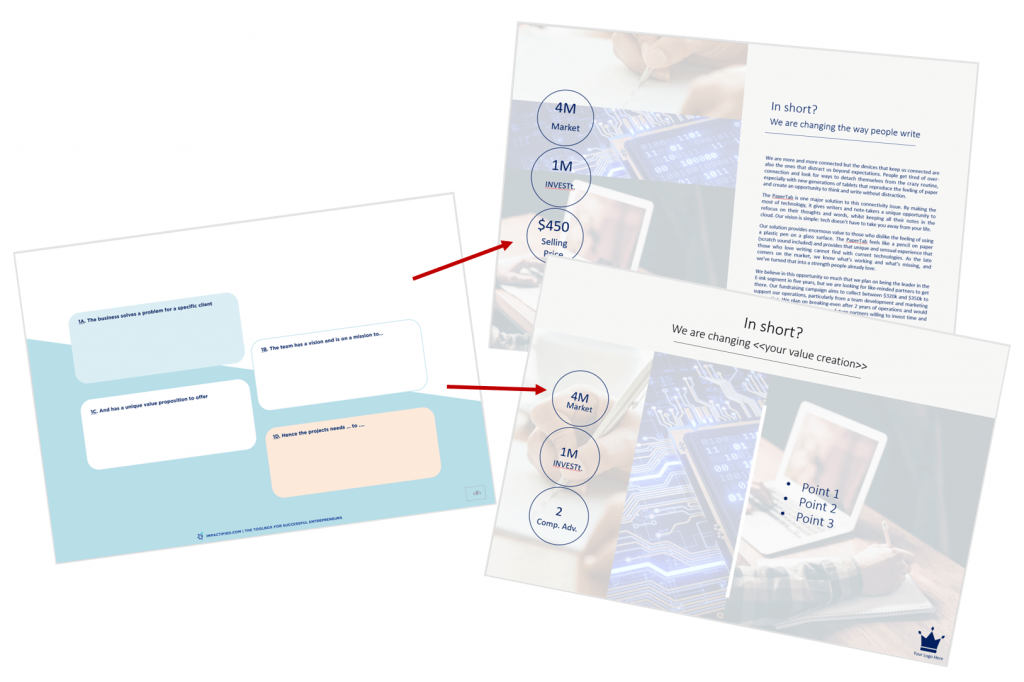
In both cases, you are free to change the pictures as you like to illustrate your own business project best. The tool comes in as a Powerpoint type of file, so you really have full freedom to adapt the template the way you like.
Last business plan writing recommendations
Now that we’ve explained to you how to write a business plan step by-step, let us shift to the topic of formatting.
Business plan formatting is a tricky topic and there are several schools of thought worth considering here: the one-page business plan, the lean model, the comprehensive formatting, and the succinct (or pitch deck) formatting.
One page business plans are a very (very very) simple overview of a business. It’s a popular method in the business literature and many authors put it forward as a business-friendly way of doing things, but in our experience as business advisers, just one page doesn’t get you anywhere close to something solid. People want to see numbers and something solid showing that you are the master on board, and just a one-pager isn’t enough.
The lean business plan template is typically the Business Canvas model by Osterwalder and Pigneur and we mentioned it before. The question is, how do you use it? Ultimately, the Business Canvas is very graphic and helps with mapping your plans, but it doesn’t help you figure out what to write and how to do it.
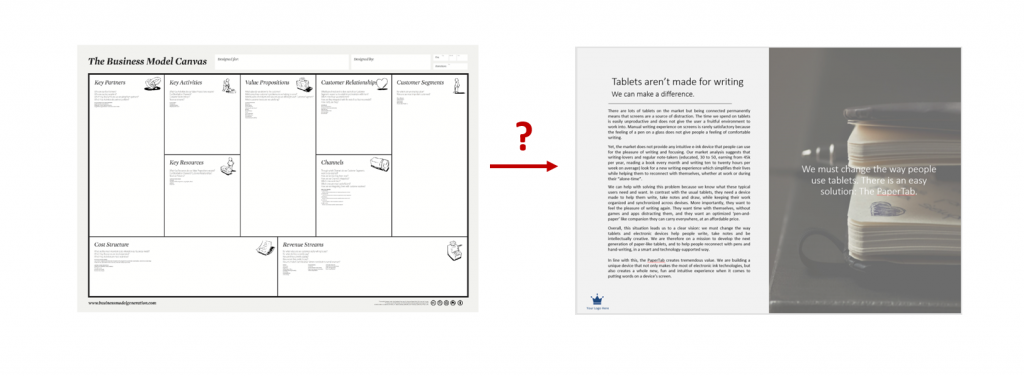
Next, the comprehensive approach leads to a business plan format that contains texts and information, with a view to inform readers who don’t have you in front of them. This is typically the type of format we’ve showed you so far and it’s very helpful when it comes to formulating things (for you) and to getting into the details (for whoever is reading the document). The problem is, this format may contain too much text for some of your interlocutors.
Hence, the succinct or pitch deck approach rather focuses on very little text (as in, very very very little text) because it is targeted at readers (investors) who will only spend seconds on the document before getting a first impression. What they need, that is, is sharp titles, numbers, short bullet points and very illustrative slides.
See for yourself:
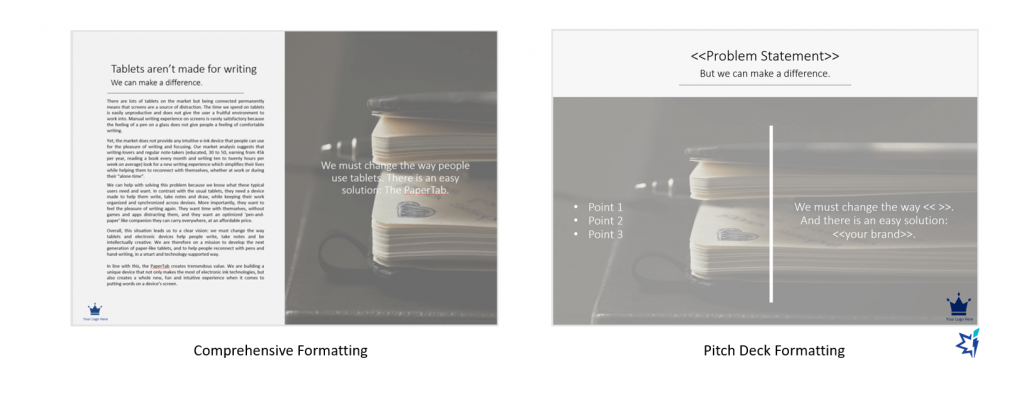

Playing it smart.
Now, we get a question regularly: should you work on both? The answer to that question is very straightforward: it depends.
If you already have a clear (as in, very clear) idea of what your business is about, and about the storytelling that comes with it, you would probably manage to do something good directly from the pitch deck.
In our experience, however, most people have no clear idea of what their model is, of what their competitive environment is, and of what exactly they are after when looking for money. In that case, starting with the comprehensive business plan format is strongly advisable. Once you have the story and the details, you’ll be equipped to work on the pitch deck anyway so there is no loss of time.
In any case, the Business Plan Builder comes in with both formats so feel free to give them a try…
And, of course…
Before we let you go, we’d like to add a couple of additional recommendations which often end up being useful (oh yeah).
First, don’t be over-optimistic. We mentioned before that it is wise to build several scenarios, and the reason we say that is that we often see entrepreneurs going straight into the well when they pitch an ideal case that ignores a harsh reality: shit happens. So, find a happy medium. Have some ambition, but make it realistic if you want people to take you seriously.
Second, avoid generalities. Again, we’ve seen (and heard) too many entrepreneurs dreaming alive about conquering just 1% of the Chinese market, and get upset when we read business advisers out there telling you to aim for being the best French restaurant in Japan when there is literally no way to make that target realistic and measurable. Again, going for a reasonable route is often smart.
Third, take the business plan writing exercise seriously, and do it for yourself first. Yes, others will want to see it, and yes it will keep evolving over time. Still, a business plan is there to help YOU move ahead and forward. Use it as a tool more than as a constraint!
Fourth, do it yourself and involve your team, but don’t just rely on someone from the outside. There are tons of professional business plan writers out there, but considering the importance of your plan from a storytelling, planning and structuring perspective, can you see what you’d be missing? Professional writers can help when your business needs to scale up, but otherwise, you simply don’t need a business plan consultant. Period.
Last but not least, don’t be scared to ask for help!
We know for sure that business plan drafting is a difficult exercise, whether you run a small business or a big one, and that having someone to bounce with is super duper important. Find a friend, find a partner, find a business coach (book an Impactified business coach here), find who you want, but don’t stay alone or your proposal will only be a fraction of what it could be.
Looking for a free business plan template pdf?
Right! As promised in the introduction of this article, we know that this type of work is a big thing to complete, so we’ve turned this article into a .pdf document that you can download for free right here. Please make sure to input a valid email address in the box, because we’ll also send you our free business plan template – it’s a free simple business plan template built with the Builder, so it will be very much aligned with everything you’ve read here. AND we’ll sign you up for our 5-day business plan mini-course.
The template and the mini-course are normally worth $49 but we’re making them available for free for a limited time, so make sure you download yours now!
Meet The Business Plan Builder: 2 hours of tutorial videos and the tools you need to get started
If you need more help to build your business plan, The Business Plan Builder is otherwise the only tool you’ll need, and at that price, you’d be silly not to use it. The Builder comes very handily, in the shape of a Module built around over 2 hours of explanatory videos and a package you’ll be able to use to
- Figure out what you need to figure out – powerful, uh?
- Understand the business plan code
- Write your business plan – with just the right amount of words and pages
- Build your financial estimates – with an automated table
- Create a visually appealing (designer-made!) document, and deck people will want to read
If you want to stop wasting your time, this is THE most simple business plan template, and you can’t afford to miss it!
Of course, if you want to explore your business model a bit further, you can also book a session with one of our business coaches. They’ll help you go through the document and will push you to think differently. What are you waiting for?
